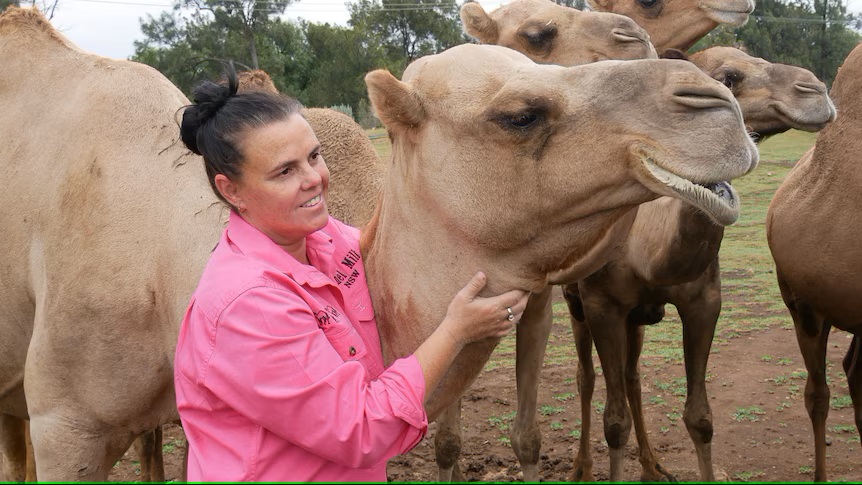
When you think of camels, you probably envision them in a dry, desert environment, not in the lush green paddocks of the Hunter Valley in New South Wales.
On the outskirts of Muswellbrook, more than 50 camels roam Michelle Phillips’s 40-hectare property.
Ms Phillips runs the only certified camel dairy in the state, in a journey that started a decade ago.
She was eager to try camel’s milk after researching its health benefits.
“Back then, there was only one commercial [camel] dairy in Australia and that was in Western Australia.
“To get fresh milk was a plane ticket and I just couldn’t afford that.”
She had also read about the country’s large feral camel population and that they were subject to mass culling.
“I found that really, really devastating,” she said.
“I thought, ‘I can’t rescue all of them, but maybe I could bring some here’.”
Wild camels to the dairy
Camels were introduced to Australia in the 1840s to assist with exploring arid areas of the country.
According to FeralScan, an initiative run by the Centre for Invasive Species Solutions, Australia’s feral population has grown to roughly 1 million camels.
The animals have long been a headache for farmers, destroying fences and infrastructure, causing overgrazing and erosion and fouling of waterways.
WATCH
But Ms Phillips is part of a group of advocates wanting more Australians to make use of the animals.
In 2014, she travelled to Peterborough in South Australia to buy a group of feral camels from a local Aboriginal man with experience mustering the wild animals.
“We started with five mothers and six babies,” Ms Phillips said.
The next challenge was learning to milk them.
“It wasn’t like I could go to the next-door neighbour and say: ‘Hey, how do I milk a camel?'”
Ms Phillips said it took months to break in the animals and gain their trust to eventually milk them using a portable milking machine.
“We’ve just got to remember they aren’t a breed of milking camels. They’re completely wild,” she said.
“They’ve been given a bit of a bad rap.
“But they’re an amazing creature to work with.”
Creating a business
Ms Phillips initially kept the milk for personal use but soon discovered a demand for the product.
“I posted on Facebook saying we were milking camels and not too long after I drove out the driveway and there were six cars parked out the front,” she said.
“They said, ‘We’ve seen you on Facebook, we want your milk’.”
Ms Phillips now owns 50 camels, including calves, and supplies several independent grocers in Western Sydney.
“It’s huge out around Auburn, Canterbury, Bankstown. We have a huge following from the Muslim community.”
Imam Mohamed Hamed, from Newcastle’s Mayfield Mosque, said camel’s milk was one of the most popular milks in Middle Eastern and northern African countries.
He said it was mentioned in the Quran for its medicinal qualities and valued highly in Islamic religion.
“But even before Islam, Arab and Persian civilisations used to use camel milk as a way of medication and a source of rich food,” Imam Hamed said.
Demand for camel’s milk is growing in Australia, however with just seven certified dairies, supply is fairly limited.
One camel produces four to five litres every milking, which is significantly less milk than a dairy cow.
It means the product is more expensive; between $20 and $25 per litre.
Camel vs cow
Ms Phillips describes camel’s milk as fairly similar to cow’s milk, with some noticing a salty note.
“It is thin on the palate but that’s because it’s really low in fat, like a skim milk,” she said.
LaTrobe University nutrition and dietetics lecturer Susan McLeod, a registered nutritionist, said camel’s milk was a “fantastic” alternative to cow’s milk.
“It’s a good source of protein, it’s low in saturated fat, it’s full of vitamins and minerals that are beneficial,” she said.
“One study shows camel milk is actually three times higher in vitamin C than cow milk.”
Ms McLeod said due to its protein make up, some people who had an allergy to cow’s milk were able to drink camel’s milk instead.
There are suggestions camel’s milk can be used as an alternative for people who are lactose intolerant, but Ms McLeod said more research was needed to validate these claims.
You can now read the most important #news on #eDairyNews #Whatsapp channels!!!
🇺🇸 eDairy News INGLÊS: https://whatsapp.com/channel/0029VaKsjzGDTkJyIN6hcP1K
























